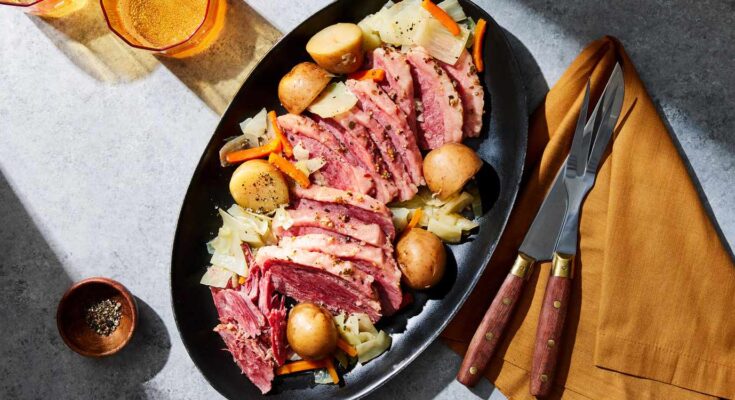Corned Beef Slow Cooker Recipe: If you’ve ever wondered how to take a tough cut of meat and turn it into something so tender it practically melts in your mouth, then corned beef in the slow cooker is your answer. Corned beef has long been associated with comfort food, family dinners, and festive occasions like St. Patrick’s Day. Traditionally, people would spend hours boiling it on the stove, carefully watching the pot and adjusting the heat. But with today’s busy schedules, who has time for that? That’s where the slow cooker steps in as a game-changer.
Using a slow cooker takes the guesswork out of the process. It allows the corned beef to simmer gently for hours, breaking down its tough fibers and infusing it with rich, savory flavors. The slow, even heat ensures that not only the meat becomes tender, but the vegetables added alongside also soak up the delicious juices. Imagine finishing a long day and walking into your kitchen filled with the aroma of perfectly cooked beef, soft potatoes, and fragrant spices. That’s the magic of this cooking method.
Another reason this recipe is beloved is its simplicity. You don’t need fancy techniques or complicated ingredients—just a good cut of corned beef, some hearty vegetables, and your slow cooker. It’s the kind of recipe anyone can master, whether you’re a beginner in the kitchen or an experienced home cook looking for a hassle-free dinner option. Plus, slow-cooked corned beef isn’t just tasty on the first night. The leftovers can be turned into sandwiches, hash, or even a quick soup, making it a versatile dish that keeps on giving.
So, if you’re ready to prepare a hearty, flavorful, and family-approved meal without spending hours in the kitchen, let’s dive into the details of this slow cooker corned beef recipe.
Ingredients You’ll Need for Corned Beef
Before you plug in your slow cooker, let’s talk about the ingredients. The beauty of corned beef is that it requires only a handful of items to create a deeply satisfying meal. However, a few optional additions can take it to the next level if you’re looking to customize the flavor.
Essential Ingredients:
- Corned Beef Brisket (3–4 pounds): The star of the dish. Most corned beef briskets come pre-brined and include a spice packet.
- Carrots (4–5 medium): Peeled and cut into large chunks for sweetness and texture.
- Potatoes (6–8 small red or Yukon gold): Keep them whole or halved, depending on size. They soak up the juices beautifully.
- Cabbage (1 small head): Quartered or cut into wedges, added toward the end for tenderness without falling apart.
- Onion (1 large): Adds depth and sweetness to the broth.
- Garlic (4–5 cloves): Crushed for a subtle aromatic base.
- Beef Broth or Water (4 cups): The cooking liquid that keeps everything moist.
Optional Flavor Boosters:
- Mustard seeds or extra pickling spices: Enhance the seasoning if your brisket doesn’t come with a spice packet.
- Bay leaves (2–3): For earthy notes.
- Beer (1 bottle, preferably lager or stout): Adds richness and complexity to the broth.
- Fresh herbs (thyme or parsley): For garnish and a fresh finish.
Choosing the Best Cut of Corned Beef:
When shopping, you’ll notice corned beef typically comes in two cuts—point cut and flat cut.
- Point cut has more marbling and fat, making it incredibly flavorful and juicy but slightly irregular in shape.
- Flat cut is leaner, easier to slice neatly, and still tender when slow-cooked.
Most people prefer flat cut for presentation, especially if serving guests, but either works wonderfully in the slow cooker.
By gathering these ingredients, you’ll have everything ready to create a wholesome meal that feels special but doesn’t require a lot of fuss.
Kitchen Tools and Equipment Required
Cooking corned beef in a slow cooker doesn’t require a professional kitchen setup. With a few key tools, you’ll be set to make this dish with ease.
The Slow Cooker:
- Size Matters: For a 3–4 pound brisket, a 6-quart slow cooker works best. If you’re making a smaller brisket (2–2.5 pounds), a 4-quart cooker will do.
- Types of Slow Cookers:
- Basic manual slow cookers with low, medium, and high settings work perfectly.
- Programmable models with timers are a bonus, especially if you want it to switch to “warm” mode automatically after cooking.
Essential Kitchen Utensils:
- Cutting Board and Sharp Knife: For prepping vegetables and slicing the cooked brisket.
- Tongs: To easily turn or remove the meat.
- Large Serving Spoon: Perfect for scooping up vegetables and broth.
- Measuring Cups: For adding broth, beer, or water in accurate amounts.
Storage and Reheating:
- Airtight Containers: Store leftovers safely in the fridge for up to 4 days.
- Freezer Bags or Vacuum Seal Bags: Corned beef freezes well for up to 2 months.
- Microwave-Safe Plates or Ovenproof Dishes: For reheating without drying out the meat.
Having the right tools may seem like a small step, but it makes the cooking and serving process seamless. Think of it like gearing up before a road trip—you’ll enjoy the journey more when you’re prepared.
Preparing Corned Beef Before Cooking
Preparation is everything when it comes to a successful slow-cooked corned beef. While the recipe is straightforward, taking a few extra minutes to prep properly will enhance the final results.
Rinse the Brisket:
Corned beef is typically cured with salt, and while this gives it that distinctive flavor, it can sometimes be too salty. Rinsing the brisket under cold water before placing it in the slow cooker removes excess brine and ensures the dish won’t be overwhelming. Don’t worry—the flavor will remain intact.
Trim Excess Fat:
Depending on your cut, there may be a thick fat cap on the brisket. Leaving some fat helps with flavor and tenderness, but trimming off large, tough pieces prevents greasiness in the broth.
Prep Vegetables:
- Carrots should be cut into hearty chunks so they don’t disintegrate.
- Potatoes can be left whole if small or halved if larger.
- Onions should be quartered or thickly sliced.
- Garlic cloves should be lightly smashed to release flavor without burning.
Layer Ingredients in the Slow Cooker:
The order matters:
- Place onions, carrots, and potatoes on the bottom to create a “bed.”
- Lay the brisket on top of the vegetables, fat side up, so the juices baste the meat as it cooks.
- Sprinkle the spice packet or seasonings over the beef.
- Pour in broth (or beer) until the meat is almost covered.
- Add cabbage wedges during the last 2 hours of cooking to prevent them from becoming mushy.
Proper preparation ensures each component of the meal is cooked to perfection—vegetables tender but not falling apart, meat juicy but not greasy, and broth flavorful without overpowering saltiness.
Step-by-Step Slow Cooker Corned Beef Guide
Now that everything is prepped, it’s time to put it all together. The slow cooker will do most of the work, but here’s a detailed guide to help you get restaurant-quality results right at home.
Step 1: Rinse and Season the Meat
After rinsing and trimming the brisket, place it into the slow cooker. Sprinkle the spice packet (or your own spice blend) evenly over the top. This will infuse flavor as the meat cooks low and slow.
Step 2: Add Vegetables and Aromatics
Layer carrots, potatoes, onions, and garlic around the brisket. If using beer, pour it in first, then add broth until the meat is nearly submerged. This mixture will create a rich cooking liquid.
Step 3: Set Cooking Time and Temperature
- Low setting: 8–10 hours (best option for maximum tenderness)
- High setting: 4–5 hours (works in a pinch, but the meat won’t be quite as melt-in-your-mouth tender)
Step 4: Check Tenderness and Doneness
After the cooking time, test the beef with a fork. If it pierces easily and the meat starts to pull apart, it’s done. If it feels tough, let it continue cooking another 30–60 minutes.
Step 5: Serving Suggestions
Remove the beef, slice it against the grain, and serve it with the cooked vegetables. Drizzle some of the broth over the top for extra flavor. Corned beef pairs beautifully with mustard, horseradish cream, or even a splash of vinegar for brightness.
And just like that, you’ve created a hearty, flavorful meal with minimal effort—all thanks to your slow cooker.
Tips for Perfectly Tender Corned Beef
One of the most common questions home cooks ask is: How do I make sure my corned beef turns out tender and juicy instead of tough? The answer lies in a combination of patience, proper cooking techniques, and a few simple tricks. Let’s break them down so you’ll never have to worry about chewy brisket again.
Cook Low and Slow
Corned beef is a brisket cut, which comes from the cow’s chest. This part of the animal is heavily worked, meaning the muscle fibers are dense and packed with connective tissue. The only way to break down those fibers is through slow, moist cooking. That’s why the slow cooker is your best friend—it provides a consistent low heat that gently transforms the meat into a tender masterpiece.
Don’t Rush the Process
It might be tempting to crank your slow cooker up to “high” to speed things along, but you’ll sacrifice tenderness. The longer the meat cooks at a gentle heat, the softer it becomes. Aim for 8–10 hours on “low” whenever possible. Think of it like baking bread—you can’t rush the rise, and you can’t rush corned beef either.
Let It Rest Before Slicing
Just like with steak, resting your corned beef after cooking is essential. Once it’s done, transfer it to a cutting board, tent it with foil, and let it rest for 10–15 minutes. This allows the juices to redistribute throughout the meat rather than running out when you slice it.
Slice Against the Grain
Perhaps the most important tip of all: always slice corned beef against the grain. The “grain” refers to the direction of the muscle fibers. Cutting across them shortens those fibers, making each bite easier to chew. Cutting with the grain, on the other hand, leaves long strands of meat that can feel stringy and tough.
By following these tips, you’ll ensure every bite of corned beef is flavorful, tender, and restaurant-worthy.
Flavor Variations to Try
One of the best things about slow cooker corned beef is its versatility. While the traditional version with potatoes, carrots, and cabbage is a classic for good reason, there’s no rule saying you can’t get creative. With just a few tweaks, you can create unique versions that suit your taste buds or bring a fresh twist to your dinner table.
Beer-Braised Corned Beef
Swap out part of the broth for a bottle of lager, ale, or stout. Beer adds depth and a slightly malty richness to the dish. A dark stout like Guinness creates a bold, almost caramel-like broth, while a lighter beer gives a more subtle flavor.
Sweet and Tangy Twist
For a flavor balance that combines savory with sweet, add a few tablespoons of brown sugar, honey, or maple syrup to the cooking liquid. You can also include a splash of apple cider vinegar for brightness and tang.
Garlic and Herb Infusion
Boost the aromatics by tossing in extra garlic cloves, fresh thyme sprigs, or bay leaves. Rosemary also works well, lending a fragrant, pine-like aroma to the broth.
Spicy Kick
If you love heat, consider adding a teaspoon of red pepper flakes or a couple of sliced jalapeños into the pot. The spice blends beautifully with the salty beef and hearty vegetables.
Asian-Inspired Corned Beef
Try replacing the traditional spice packet with soy sauce, ginger, and star anise for a unique fusion flavor. Serve with steamed rice instead of potatoes for a complete twist on the classic dish.
These variations show how corned beef isn’t limited to one recipe. By experimenting with flavors, you can create meals that surprise and delight your family while still enjoying the convenience of a slow cooker.
What to Serve with Slow Cooker Corned Beef
Corned beef is filling on its own, but pairing it with the right sides and accompaniments elevates the entire meal. Whether you’re cooking for a holiday gathering or a cozy weeknight dinner, here are some delicious serving ideas.
Classic Pairings:
- Boiled or Buttered Potatoes: Simple yet hearty, they soak up the flavorful juices.
- Steamed or Roasted Cabbage: Traditionally served alongside corned beef, it balances the richness of the meat.
- Carrots and Onions: Cooked right in the slow cooker, they’re naturally sweet and tender.
Bread and Condiments:
- Irish Soda Bread: Slightly sweet and dense, perfect for sopping up juices.
- Mustard or Horseradish Cream: A tangy condiment that cuts through the richness of the beef.
- Pickles: Their briny bite complements the saltiness of the meat.
Lighter Sides for Balance:
- Green Salad: Crisp greens with a lemon vinaigrette add freshness.
- Roasted Brussels Sprouts: Their nutty flavor pairs beautifully with corned beef.
- Coleslaw: A crunchy, tangy side that lightens up the meal.
Beverage Pairings:
- Beer: A pint of Guinness or lager is the traditional choice.
- Red Wine: A medium-bodied wine like Merlot or Zinfandel works surprisingly well.
- Sparkling Water with Lemon: For a lighter, refreshing option.
By mixing and matching these side dishes and drinks, you can create a complete dining experience that feels hearty yet balanced.
Common Mistakes to Avoid When Cooking Corned Beef
Even though this dish is simple, a few common mistakes can make the difference between a tender, flavorful meal and one that’s disappointing. Here’s what to watch out for.
Skipping the Rinse
Because corned beef is brined, failing to rinse it can make the final dish overly salty. A quick rinse under cold water won’t remove the flavor, just the excess brine.
Overcooking the Vegetables
Vegetables like cabbage cook much faster than beef. If you toss them in at the beginning, they’ll turn mushy. Instead, add cabbage wedges during the last 2 hours of cooking.
Cooking on High the Entire Time
Yes, you’ll save time, but you’ll also sacrifice tenderness. Corned beef needs low heat and time to break down its connective tissues properly.
Slicing the Meat Wrong
Cutting with the grain leaves long, chewy strands. Always slice against the grain for maximum tenderness.
Not Using Enough Liquid
The brisket should be almost fully submerged in broth, water, or beer. Without enough liquid, the meat can dry out, and the vegetables may scorch.
Avoiding these pitfalls ensures your corned beef will turn out flavorful and tender every single time.
How to Store and Reheat Corned Beef
One of the best things about corned beef is how well it keeps. Leftovers not only reheat beautifully but can also be transformed into completely new meals. Proper storage and reheating methods are key to maintaining flavor and texture.
Storing Leftovers:
- Refrigerator: Place cooled corned beef and vegetables in airtight containers. Store in the fridge for up to 4 days.
- Freezer: Wrap slices of corned beef tightly in plastic wrap or foil, then place in freezer bags. It can be frozen for up to 2 months. Vegetables, however, don’t freeze as well, so enjoy them fresh.
Reheating Methods:
- Stovetop: Place slices in a skillet with a splash of broth or water, cover, and heat gently until warmed through.
- Oven: Wrap slices in foil with a little broth, then reheat at 325°F for about 15 minutes.
- Microwave: Place slices on a microwave-safe plate, cover with a damp paper towel, and heat in short bursts.
Pro Tip:
Always reheat corned beef gently. High heat can dry it out or make it tough again. Keeping it moist with a bit of broth helps preserve the tenderness you worked so hard to achieve.
With proper storage and reheating, you can enjoy corned beef for days—whether in sandwiches, salads, or hearty breakfasts.
Creative Leftover Corned Beef Recipes
Corned beef is one of those dishes that almost tastes better the next day, and the leftovers are just as exciting as the original meal. Instead of simply reheating, why not transform them into something new and delicious? Here are some mouthwatering ways to put your corned beef leftovers to good use.
Corned Beef Hash
Probably the most iconic leftover dish, corned beef hash combines diced beef with potatoes and onions, all fried until golden and crispy. Top it with a fried egg for a hearty breakfast or brunch that’s guaranteed to please.
Reuben Sandwich
Layer slices of corned beef with Swiss cheese, sauerkraut, and Russian or Thousand Island dressing between rye bread, then grill until toasted. This deli classic is a perfect way to enjoy leftovers without much effort.
Corned Beef Tacos
Give your leftovers a modern twist by shredding corned beef and stuffing it into tortillas. Add cabbage slaw, a drizzle of spicy mayo, and fresh cilantro for a fusion dish that combines Irish flavors with Mexican flair.
Corned Beef Soup or Stew
Chop the leftover beef into small chunks and simmer with broth, carrots, potatoes, and cabbage for a comforting soup. It’s a great way to stretch the leftovers into another full meal.
Corned Beef and Cheese Sliders
Use dinner rolls to make mini sandwiches with corned beef, cheese, and mustard. Toast them in the oven until gooey and melty—a crowd-pleasing appetizer or party snack.
With just a little creativity, your slow-cooked corned beef can become the star of several more meals, making it even more rewarding to prepare.
Nutritional Value of Corned Beef
Corned beef is undeniably delicious, but if you’re wondering about its nutritional profile, here’s a breakdown to help you enjoy it mindfully.
Calories and Macros (per 3-ounce serving):
- Calories: About 210
- Protein: 15 grams
- Fat: 16 grams (with 5–6 grams of saturated fat)
- Carbohydrates: 0 grams (unless paired with sides)
Micronutrients:
- Iron: Helps with energy and red blood cell production.
- Zinc: Supports the immune system.
- Vitamin B12: Essential for nerve health and metabolism.
Sodium Consideration:
The one thing to watch for with corned beef is its sodium content. Because it’s cured in brine, it can be quite salty. A typical serving may contain 800–900 mg of sodium, which is about one-third of the daily recommended intake. Rinsing before cooking and pairing it with fresh vegetables can help balance this out.
Corned beef can be part of a wholesome meal when enjoyed in moderation, especially when paired with fiber-rich veggies and lighter sides.
History and Tradition of Corned Beef
Corned beef has a fascinating history that stretches back centuries, blending cultural influences and traditions.
Origins of Corned Beef
The term “corned” refers to the large grains (or “corns”) of salt historically used to cure beef. This preservation method was common in Europe, especially Ireland and England, where it allowed meat to last longer before refrigeration existed.
Irish Connection
Interestingly, while corned beef is often associated with Irish cuisine, it wasn’t a common food in Ireland itself. Beef was expensive there, and pork (like bacon) was more common. Irish immigrants in America, however, found corned beef more affordable than back home and began pairing it with cabbage, a cheap and plentiful vegetable. This is how the iconic “corned beef and cabbage” dish became linked to Irish-American culture and St. Patrick’s Day celebrations.
Modern Popularity
Today, corned beef is enjoyed worldwide. In the U.S., it’s a staple for March 17th festivities, while in the U.K. and parts of the Caribbean, canned corned beef is a pantry staple. The slow cooker has brought it back into the spotlight as an easy way to prepare this traditional meal with minimal effort.
Understanding its history makes every bite feel a little more meaningful, connecting you to centuries of culinary tradition.
Corned Beef for Holidays and Special Occasions
Corned beef isn’t just an everyday comfort food—it’s also a centerpiece for special occasions.
St. Patrick’s Day Favorite
For many households, corned beef and cabbage is the ultimate St. Patrick’s Day dish. Families gather around the table, and the slow cooker makes it easy to prepare while you enjoy the festivities. Paired with Irish soda bread and a pint of Guinness, it’s a holiday feast like no other.
Family Gatherings
Corned beef works wonderfully for Sunday dinners, family reunions, or potluck events. It’s hearty, budget-friendly, and can feed a crowd with little stress.
Casual Weeknight Meal
Surprisingly, corned beef isn’t limited to special days. With a slow cooker, you can make it part of your weekly dinner rotation. Leftovers mean you’re set for multiple meals, saving both time and money.
Festive Touch
Want to make it extra special? Garnish your platter with fresh parsley, serve with a variety of mustards, and present it family-style in the center of the table. The warm, inviting look instantly turns dinner into an occasion.
Whether it’s a holiday or just a regular Wednesday night, corned beef can adapt to the moment, always delivering flavor and comfort.
FAQs about Corned Beef Slow Cooker Recipe
1. Can I cook corned beef without a spice packet?
Yes, you can make your own blend with mustard seeds, peppercorns, coriander seeds, and bay leaves.
2. Should I cook corned beef fat side up or down in the slow cooker?
Fat side up works best, as the fat bastes the meat while it cooks.
3. Can I make corned beef in advance?
Absolutely. Corned beef reheats beautifully and can even taste better the next day.
4. How do I know when corned beef is done?
It should be fork-tender. If a fork easily pierces the meat and it begins to fall apart, it’s ready.
5. Can I skip the cabbage?
Yes. While traditional, cabbage is optional. You can replace it with Brussels sprouts, green beans, or your favorite veggies.
Conclusion
Not only is it rich in history and tradition, but it also offers endless ways to enjoy—from hearty family dinners to sandwiches, soups, and beyond. Whether you’re cooking it for St. Patrick’s Day, a cozy weekend dinner, or just to stock up on leftovers, this recipe is one you’ll come back to again and again.
So, grab your slow cooker, gather your ingredients, and let time do the rest. By the end of the day, you’ll have a meal that fills your home with irresistible aromas and your table with smiles.



